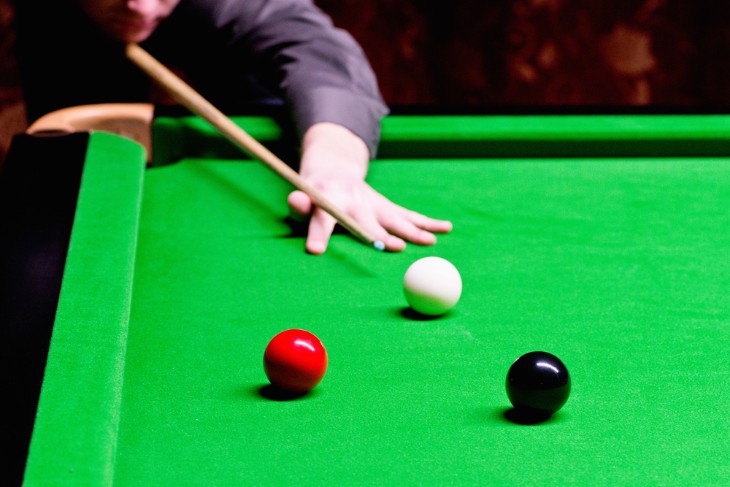The Art of Snooker Comebacks
In the world of snooker, a comeback typically occurs when one player faces a significant point deficit during a match and manages to turn the tide, coming out victorious. It involves a combination of tactical prowess, flawless execution, and, most importantly, unyielding focus. Players who master the art of comebacks possess an innate ability to maintain their composure under pressure, recalibrate their strategies, and seize control of the match. These comebacks are not mere fluctuations of fortune but intricate displays of skill that keep audiences on the edge of their seats, highlighting the beauty of snooker as a sport that rewards both precision and resilience.
The Legendary Rivalry: Davis vs. Higgins
Among the pantheon of snooker legends, the rivalry between Steve Davis and Alex Higgins stands out as one of the most iconic chapters in the sport's history. Their duels on the green baize were not only a demonstration of their contrasting playing styles but also bore witness to some of the most unforgettable comebacks in snooker lore.
Davis, known for his meticulous approach and unwavering consistency, often faced the unpredictable brilliance of Higgins, whose flair for the dramatic could turn a match on its head in an instant. Their encounters were more than just battles of cue ball control; they were psychological showdowns. In these matches, Davis demonstrated his mastery of patience and precision, while Higgins relied on his innate talent and fearless shot-making.
Higgins' Remarkable Recovery
Alex Higgins, often referred to as the "Hurricane" for his frenetic and unpredictable playing style, was no stranger to the art of snooker comebacks. His career was punctuated by moments of brilliance and inconsistency, making him one of the most intriguing figures in the sport's history. Higgins possessed an uncanny ability to rally from seemingly insurmountable deficits, and it was this resilience that cemented his legacy.
One of the most memorable examples of Higgins' remarkable comebacks came during the 1982 World Snooker Championship final against Ray Reardon. Down 9-15, Higgins staged a dramatic resurgence, winning four consecutive frames to level the match at 15-15. The tension in the Crucible Theatre was palpable as Higgins displayed his characteristic flair, potting balls with flair and precision. In the end, he secured a thrilling 18-15 victory, claiming his second world title. This iconic comeback not only showcased his snooker prowess but also his ability to captivate audiences with his fearless approach to the game.
Davis' Tenacity and Precision
In stark contrast to Higgins, Steve Davis epitomized the virtues of tenacity and precision in snooker. His style of play was characterized by methodical shot selection, meticulous cue ball control, and an unshakable focus on consistency. Davis was renowned for his exceptional ability to grind out victories, and his comeback stories often revolved around his unwavering resolve.
One of the most notable instances of Davis' tenacity and precision was his comeback in the 1985 World Snooker Championship final against Dennis Taylor. Trailing 8-0 in the early stages of the match, Davis displayed his mettle by clawing his way back into contention, winning seven consecutive frames. Although he ultimately lost the match in the famous black-ball decider, Davis' spirited fightback from such a daunting deficit remains a testament to his determination. Davis demonstrated that in snooker, comebacks are not limited to winning matches; they also include the determination to fight back when the odds seem insurmountable.

A Match for the Ages: Taylor vs. White
The world of snooker has witnessed its fair share of epic battles, but few have captured the imagination of fans as intensely as the 1985 World Snooker Championship final between Dennis Taylor and Jimmy White. This match, often referred to as a "Match for the Ages," was a rollercoaster of emotions and a showcase of two contrasting playing styles.
Jimmy White, known for his flamboyant and daring approach, had the crowd on their feet with his breathtaking potting and fearless shot-making. He took an early lead against Dennis Taylor, who was a seasoned campaigner known for his meticulous safety play and tactical acumen. However, what made this match truly iconic was Taylor's ability to mount a remarkable comeback.
Trailing 7-0, Taylor began a slow and methodical resurgence. He showcased the importance of patience and precision in snooker, gradually narrowing the point deficit. The climax of the match came with the famous black-ball finish in the deciding frame, where Taylor potted the final black to secure a nail-biting victory.
White's Grit and Determination
The fast and aggressive style of Jimmy White earned him the nickname "Whirlwind". His grit and determination were unparalleled in the world of snooker. Despite facing numerous disappointments and near misses in major tournaments, White's resolve to achieve greatness never wavered.
One of the most poignant moments in White's career came during the 1992 World Snooker Championship final against Stephen Hendry. White had previously lost in six World Championship finals, and the pressure to finally claim the title was immense. In this high-stakes match, White faced a formidable opponent in Hendry, a player known for his dominance. Trailing 14-8, White showcased his grit and determination by mounting a spirited comeback, winning four consecutive frames to level the match at 14-14. However, Hendry ultimately prevailed in the deciding frame, denying White the elusive title once again. Despite the heartbreak, White's comeback in that final remains an iconic moment in snooker history, illustrating his tenacity and resilience in the face of adversity.
The Rocket's Stunning Comeback
Ronnie O'Sullivan, known as "The Rocket" for his lightning-fast playing style, has been a dominant force in snooker, thanks in part to his ability to engineer stunning comebacks on the green baize. O'Sullivan's comeback artistry is characterized by his extraordinary talent, versatility, and a capacity to thrive under pressure.
One of O'Sullivan's most iconic comebacks unfolded during the 2007 Masters final against Ding Junhui. Trailing 5-1, O'Sullivan found himself in a seemingly insurmountable situation. However, he displayed incredible skill and composure, embarking on an astonishing comeback by winning eight consecutive frames. His precision, break-building ability, and tactical acumen were on full display as he secured a remarkable 10-3 victory. O'Sullivan's comeback in this final was not just a demonstration of his snooker prowess but also a testament to his mental resilience, proving that even in the face of significant deficits, he could rise to the occasion and emerge victorious.
One of the most remarkable comebacks in Ronnie O'Sullivan's career occurred when he returned to snooker after a self-imposed sabbatical. His hiatus had raised doubts about his future in the sport, but O'Sullivan made a stunning comeback, winning the 2012 World Snooker Championship. What made this achievement even more remarkable was that he was behind 12-9 in the final against Ali Carter before mounting a remarkable comeback to win 18-11. O'Sullivan's rebound not only solidified his status as one of the greatest snooker players of all time but was also one of the greatest examples of the power of determination and self-belief in the face of adversity.

The Resilience of John Higgins
John Higgins, a snooker legend in his own right, has shown remarkable resilience throughout his career, making him one of the most respected figures in the sport. One of the hallmarks of his success is his ability to bounce back from adversity and adapt to different playing conditions.
One of the standout moments in Higgins' career was his comeback in the 2009 World Snooker Championship final against Shaun Murphy. Trailing 6-2, Higgins faced a formidable opponent in Murphy, who was in top form. However, Higgins displayed his grit and determination by clawing his way back into the match, ultimately securing a dramatic 18-9 victory. What made this recovery particularly impressive was that Higgins readjusted his game and strategy to counter Murphy's strengths. He successfully navigated the tactical aspects of the game and demonstrated impeccable cue ball control. John Higgins' rebound in the 2009 World Championship final is a testament to his resilience and his ability to rise to the occasion when it matters most in the world of snooker.
Modern Icons: Robertson and Trump
Two more recent players who are icons of the sport are Neil Robertson and Judd Trump. Both have redefined the game with their attacking play and consistency, each with their unique style and remarkable comeback stories.
- Neil Robertson, the Australian left-hander, is renowned for his relentless break-building and tactical prowess. One of his memorable comebacks took place in the 2013 UK Championship final against Mark Selby. Trailing 5-1, Robertson mounted a stunning revival, showcasing his tactical astuteness and potting ability. He won seven consecutive frames to secure an 11-8 victory, capturing his second UK Championship title. Robertson's comeback underscored his mastery of the game's intricacies, making him a modern icon of snooker.
- Judd Trump, known for his attacking and flamboyant style, has also had his share of remarkable comebacks. His 2019 World Snooker Championship semi-final against Gary Wilson stands out as a testament to his ability to rise from adversity. Trump faced a 5-1 deficit early in the match but staged a sensational comeback, winning seven frames in a row to clinch a 17-11 victory. His fearless potting and break-building under pressure exemplified his extraordinary talent and showcased the modern face of snooker. Both Robertson and Trump have added new dimensions to the sport and have shown that the art of snooker comebacks continues to evolve.
Conclusion
In the world of snooker, comebacks are more than just shifts in scorelines; they are narratives of resilience, determination, and the unwavering pursuit of victory. This article has delved into the fascinating realm of snooker comebacks, showcasing iconic moments from the sport's history and highlighting the legends who have left an indelible mark on the green baize.
From the legendary rivalry between Steve Davis and Alex Higgins to the modern icons of Neil Robertson and Judd Trump, snooker has produced moments of sheer brilliance that continue to captivate fans worldwide.



.webp)


 (1).webp)




















